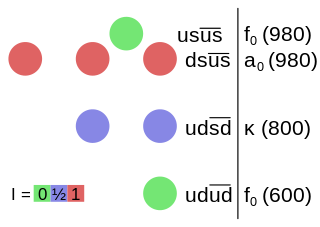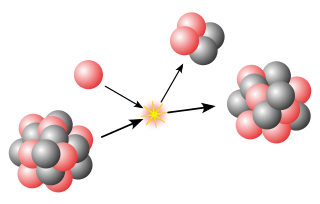Related Research Articles

In particle physics, a baryon is a type of composite subatomic particle that contains an odd number of valence quarks, conventionally three. Protons and neutrons are examples of baryons; because baryons are composed of quarks, they belong to the hadron family of particles. Baryons are also classified as fermions because they have half-integer spin.

Deuterium (hydrogen-2, symbol 2H or D, also known as heavy hydrogen) is one of two stable isotopes of hydrogen; the other is protium, or hydrogen-1, 1H. The deuterium nucleus (deuteron) contains one proton and one neutron, whereas the far more common 1H has no neutrons. Deuterium has a natural abundance in Earth's oceans of about one atom of deuterium in every 6,420 atoms of hydrogen. Thus, deuterium accounts for about 0.0156% by number (0.0312% by mass) of all hydrogen in the ocean: 4.85×1013 tonnes of deuterium – mainly as HOD (or 1HO2H or 1H2HO) and only rarely as D2O (or 2H2O) (Deuterium Oxide, also known as Heavy Water)– in 1.4×1018 tonnes of water. The abundance of 2H changes slightly from one kind of natural water to another (see Vienna Standard Mean Ocean Water).

In particle physics, a meson is a type of hadronic subatomic particle composed of an equal number of quarks and antiquarks, usually one of each, bound together by the strong interaction. Because mesons are composed of quark subparticles, they have a meaningful physical size, a diameter of roughly one femtometre (10−15 m), which is about 0.6 times the size of a proton or neutron. All mesons are unstable, with the longest-lived lasting for only a few tenths of a nanosecond. Heavier mesons decay to lighter mesons and ultimately to stable electrons, neutrinos and photons.

In physics and chemistry, a nucleon is either a proton or a neutron, considered in its role as a component of an atomic nucleus. The number of nucleons in a nucleus defines the atom's mass number.

In nuclear physics and particle physics, the weak interaction, also called the weak force, is one of the four known fundamental interactions, with the others being electromagnetism, the strong interaction, and gravitation. It is the mechanism of interaction between subatomic particles that is responsible for the radioactive decay of atoms: The weak interaction participates in nuclear fission and nuclear fusion. The theory describing its behaviour and effects is sometimes called quantum flavordynamics (QFD); however, the term QFD is rarely used, because the weak force is better understood by electroweak theory (EWT).

In particle physics, a pion or pi meson, denoted with the Greek letter pi, is any of three subatomic particles:
π0
,
π+
, and
π−
. Each pion consists of a quark and an antiquark and is therefore a meson. Pions are the lightest mesons and, more generally, the lightest hadrons. They are unstable, with the charged pions
π+
and
π−
decaying after a mean lifetime of 26.033 nanoseconds, and the neutral pion
π0
decaying after a much shorter lifetime of 85 attoseconds. Charged pions most often decay into muons and muon neutrinos, while neutral pions generally decay into gamma rays.

In particle physics, a lepton is an elementary particle of half-integer spin that does not undergo strong interactions. Two main classes of leptons exist: charged leptons, including the electron, muon, and tauon, and neutral leptons, better known as neutrinos. Charged leptons can combine with other particles to form various composite particles such as atoms and positronium, while neutrinos rarely interact with anything, and are consequently rarely observed. The best known of all leptons is the electron.
In particle physics, the hyperchargeY of a particle is a quantum number conserved under the strong interaction. The concept of hypercharge provides a single charge operator that accounts for properties of isospin, electric charge, and flavour. The hypercharge is useful to classify hadrons; the similarly named weak hypercharge has an analogous role in the electroweak interaction.
In nuclear physics and particle physics, isospin (I) is a quantum number related to the up- and down quark content of the particle. Isospin is also known as isobaric spin or isotopic spin. Isospin symmetry is a subset of the flavour symmetry seen more broadly in the interactions of baryons and mesons.

In quantum mechanics, a singlet state usually refers to a system in which all electrons are paired. The term 'singlet' originally meant a linked set of particles whose net angular momentum is zero, that is, whose overall spin quantum number . As a result, there is only one spectral line of a singlet state. In contrast, a doublet state contains one unpaired electron and shows splitting of spectral lines into a doublet, and a triplet state has two unpaired electrons and shows threefold splitting of spectral lines.

In particle physics, exotic mesons are mesons that have quantum numbers not possible in the quark model; some proposals for non-standard quark model mesons could be:
In the Standard Model of electroweak interactions of particle physics, the weak hypercharge is a quantum number relating the electric charge and the third component of weak isospin. It is frequently denoted and corresponds to the gauge symmetry U(1).
In particle physics, flavour or flavor refers to the species of an elementary particle. The Standard Model counts six flavours of quarks and six flavours of leptons. They are conventionally parameterized with flavour quantum numbers that are assigned to all subatomic particles. They can also be described by some of the family symmetries proposed for the quark-lepton generations.

The nuclear force is a force that acts between hadrons, most commonly observed between protons and neutrons of atoms. Neutrons and protons, both nucleons, are affected by the nuclear force almost identically. Since protons have charge +1 e, they experience an electric force that tends to push them apart, but at short range the attractive nuclear force is strong enough to overcome the electrostatic force. The nuclear force binds nucleons into atomic nuclei.
In particle physics, a rho meson is a short-lived hadronic particle that is an isospin triplet whose three states are denoted as
ρ+
,
ρ0
and
ρ−
. Along with pions and omega mesons, the rho meson carries the nuclear force within the atomic nucleus. After the pions and kaons, the rho mesons are the lightest strongly interacting particle, with a mass of 775.45±0.04 MeV for all three states.
In particle physics, isoscalar refers to the scalar transformation of a particle or field under the SU(2) group of isospin. Isoscalars are a singlet state, with total isospin 0 and the third component of isospin 0, much like a singlet state in a 2-particle addition of spin. Mesons which have all flavor quantum numbers equal to zero, are known as isoscalars.
In physics and particularly in particle physics, a multiplet is the state space for 'internal' degrees of freedom of a particle; that is, degrees of freedom associated to a particle itself, as opposed to 'external' degrees of freedom such as the particle's position in space. Examples of such degrees of freedom are the spin state of a particle in quantum mechanics, or the color, isospin and hypercharge state of particles in the Standard Model of particle physics. Formally, we describe this state space by a vector space which carries the action of a group of continuous symmetries.
In particle physics, isospin multiplets are families of hadrons with approximately equal masses. All particles within a multiplet, have the same spin, parity, and baryon numbers, but differ in electric charges.

Jonas Alster is an Israeli nuclear physicist.
Shalom Shlomo is a nuclear physicist, academic, and author. He is a Senior Scientist and Group Leader at the Cyclotron Institute of the Texas A&M University (TAMU).
References
- ↑ Bracco, A.; Lanza, E. G.; Tamii, A. (1 May 2019). "Isoscalar and isovector dipole excitations: Nuclear properties from low-lying states and from the isovector giant dipole resonance". Progress in Particle and Nuclear Physics. 106: 360–433. Bibcode:2019PrPNP.106..360B. doi: 10.1016/j.ppnp.2019.02.001 . hdl: 2434/716331 . ISSN 0146-6410. S2CID 127928945.